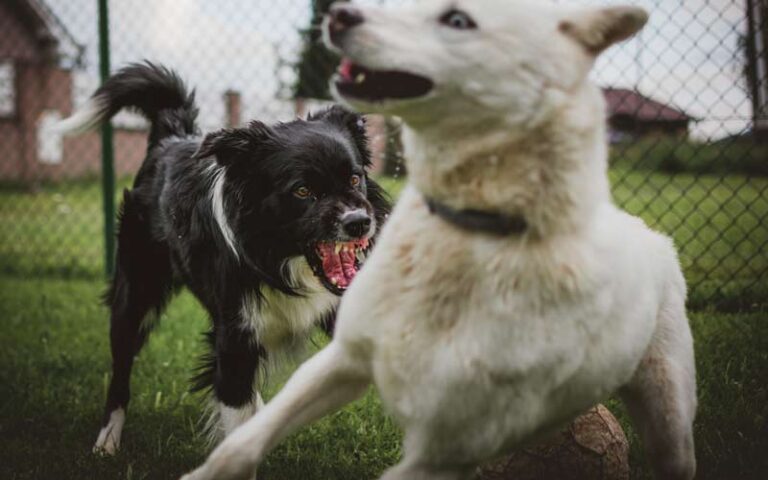Dog behavior problems can be a significant challenge which impacts the well-being of both the dog and its human family. Common issues such as excessive barking, aggression, and destructive chewing can stem from various causes, including lack of training, anxiety, or underlying medical conditions. Addressing these behaviors effectively requires a combination of understanding, patience, and often professional guidance. By identifying the root causes and implementing appropriate strategies, owners can foster a healthier and more harmonious relationship with their dogs.
Aggression
Aggression is a common dog behavior problem that can be concerning for pet owners. Understanding the types of aggression, its causes, and effective training techniques can help address this issue and create a safer environment for both the dog and its owners.
Types of Aggression
- Fear Aggression: Dogs may exhibit aggressive behavior when they feel threatened or scared. This can manifest as growling, barking, or even biting when approached or cornered.
- Dominance Aggression: Some dogs may display aggression as a way to assert their dominance over other animals or people. This can occur during feeding time, when protecting toys, or when challenged for a preferred spot.
- Territorial Aggression: Dogs may become aggressive when they feel their territory is being encroached upon. This can result in aggressive behavior towards other animals or unfamiliar people entering their space.
Causes of Aggression
- Lack of Socialization: Dogs that have not been properly socialized from a young age may exhibit aggressive tendencies towards other animals or people.
- Medical Issues: Underlying medical conditions such as pain, hormonal imbalances, or neurological disorders can contribute to aggressive behavior in dogs.
- Traumatic Experiences: Dogs that have experienced trauma or abuse in the past may be more likely to display aggression as a defense mechanism.
Training Techniques
- Positive Reinforcement: Using treats, praise, and rewards to reinforce good behavior can be a highly effective training technique for addressing aggression in dogs.
- Behavior Modification: Working with a professional dog trainer or behaviorist can help identify triggers for aggression and develop a personalized training plan to address these issues.
- Consistency and Patience: Training a dog out of aggressive behavior takes time and consistency. It’s important to remain patient and dedicated to the training process to see positive results.
By understanding the types of aggression, its causes, and implementing effective training techniques, pet owners can help their dogs overcome aggression and create a harmonious relationship with their furry companions.
Separation Anxiety
Dogs are pack animals and thrive on the companionship of their owners. When left alone for an extended period of time, some dogs may experience separation anxiety.
Signs and Symptoms
- Excessive barking or howling
- Destructive behavior, such as chewing furniture or scratching doors
- Potty accidents indoors
- Attempting to escape
- Excessive panting or pacing
Prevention Tips
- Gradually accustom your dog to being alone by leaving for short periods and gradually increasing the time.
- Provide plenty of mental and physical stimulation before leaving.
- Use calming aids, such as toys or treats, to keep your dog occupied.
- Create a safe and comfortable space for your dog to relax in while you’re away.
Treatment Options
- Consult with a veterinarian or professional dog trainer to develop a treatment plan.
- Behavior modification techniques, such as desensitization and counterconditioning, can help reduce anxiety.
- Medications may be prescribed in severe cases to help manage symptoms.
- Consider hiring a pet sitter or using doggy daycare to provide companionship while you’re away.
Excessive Barking
Does your dog bark incessantly, causing frustration and annoyance to both you and your neighbors? Excessive barking is a common dog behavior problem that can be addressed with the right training and techniques.
Reasons for Barking
There are several reasons why dogs bark excessively. It could be due to boredom, loneliness, fear, territorial behavior, or simply because they haven’t been taught when it’s appropriate to bark. Understanding the root cause of your dog’s barking is essential in effectively addressing the issue.
Training Methods
Training your dog to control their barking requires consistency and patience. Positive reinforcement techniques such as rewarding quiet behavior and ignoring excessive barking can be effective. Teaching your dog the “quiet” command and providing mental stimulation through interactive toys and puzzles can also help reduce excessive barking.
Tools and Techniques
There are various tools and techniques available to help curb excessive barking. Bark collars, citronella sprays, and ultrasonic devices are commonly used to deter barking. However, it’s important to use these tools with caution and under the guidance of a professional trainer to ensure they are used effectively and humanely.
By addressing the root cause of your dog’s excessive barking and implementing the right training methods and tools, you can effectively solve this common behavior problem and enjoy a quieter, more peaceful coexistence with your furry companion.
Destructive Chewing
Dogs have a natural instinct to chew, but destructive chewing can be a frustrating behavior problem for many pet owners. Understanding the common causes and implementing prevention strategies can help redirect this behavior.
Common Causes
- Teething: Puppies may chew excessively during their teething phase to alleviate discomfort.
- Boredom: Dogs left alone for long periods may resort to chewing out of boredom.
- Anxiety: Dogs may chew as a way to cope with separation anxiety or other stressors.
- Lack of Exercise: Dogs with pent-up energy may chew to release excess energy.
- Lack of Stimulation: Dogs need mental stimulation to prevent boredom and destructive chewing.
Prevention Strategies
- Provide Chew Toys: Offer a variety of safe and durable chew toys to satisfy your dog’s chewing needs.
- Supervise: Keep an eye on your dog, especially during the teething phase, to redirect inappropriate chewing.
- Exercise: Ensure your dog gets enough physical exercise to prevent boredom and excess energy.
- Mental Stimulation: Engage your dog in interactive games, puzzles, and training to keep their mind stimulated.
- Training: Use positive reinforcement training techniques to teach your dog what is appropriate to chew on.
Redirecting Behavior
- Catch Them in the Act: Interrupt your dog if you catch them chewing on something they shouldn’t be.
- Replace: Offer a chew toy as a replacement for the inappropriate item and praise them for chewing on it.
- Consistency: Be consistent in redirecting behavior and rewarding appropriate chewing to reinforce good habits.
- Seek Professional Help: If destructive chewing persists despite your efforts, consult a professional trainer or behaviorist for guidance.
Jumping Up
Dogs jumping up on people can be a common behavior problem that many pet owners face. Understanding the reasons behind this behavior and using appropriate training approaches can help solve this issue.
Reasons for Jumping
There are several reasons why dogs may exhibit jumping up behavior. One common reason is that dogs see jumping up as a way to greet their owners or other people in an enthusiastic manner. They may also jump up to seek attention or to show excitement. In some cases, dogs may jump up out of anxiety or fear.
Training Approaches
To address jumping up behavior in dogs, it is important to use consistent and positive training approaches. One effective approach is to teach the dog an alternative behavior, such as sitting, that they can perform instead of jumping up. This can be reinforced through rewards and praise when the dog successfully performs the desired behavior.
Positive Reinforcement
Positive reinforcement is a key component of training dogs to stop jumping up. When the dog displays the desired behavior, such as sitting instead of jumping, it is important to reward them with treats, praise, or affection. This helps to reinforce the behavior and encourages the dog to continue behaving in the desired manner. Consistency and patience are crucial when using positive reinforcement to address jumping up behavior in dogs.
Addressing common dog behavior problems requires patience, consistency, and understanding. By identifying the root cause of the behavior and implementing positive training techniques, pet owners can effectively solve these issues and strengthen the bond with their furry companions. Remember, every dog is unique and may require different approaches, so don’t hesitate to seek professional help if needed. With dedication and the right approach, you can help your dog become a well-behaved and happy member of your family.






